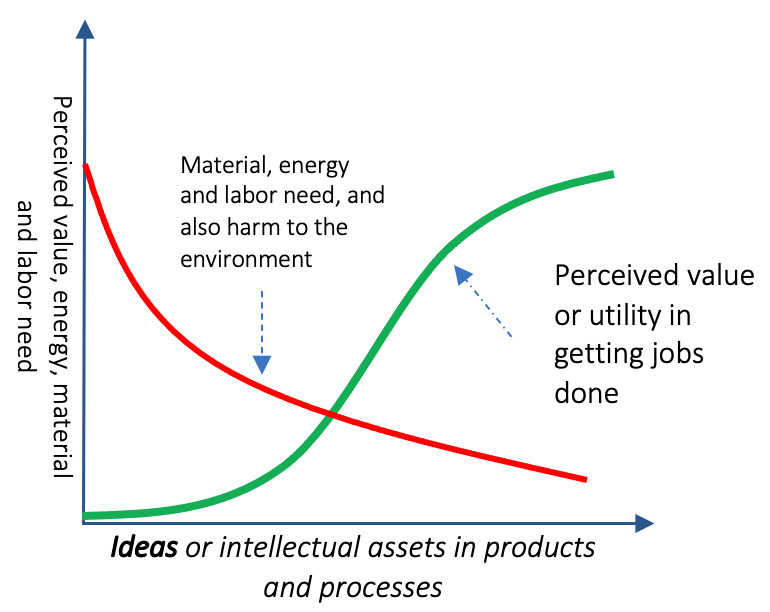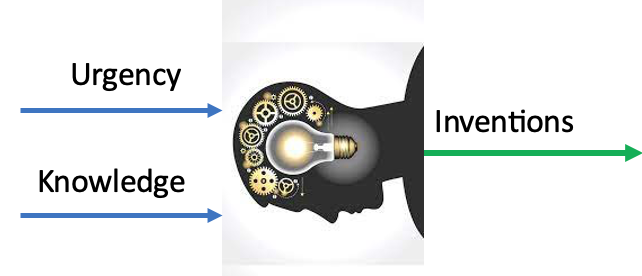We are likely scared about the impending threat of massive job loss due to the unfolding of the Fourth Industrial Revolution. How do we define the industrial revolution, and why do we care about it? As discontinuity marks the industrial revolution, we care about it. By unfolding inventions and reinventions, industrial revolutions unleash profound changes. As a result, society goes through a transformation. Along with the unfolding opportunities, jobs, firms, and industries disappear. But that demands the formation of scientific knowledge and technology cores to invent new products and processes and reinvent what we have. As a result, creative destructions unfold. Due to the Reinvention effect, prosperity also migrates, making once resourceful towns and nations deserted. Why do industrial revolutions unleash as destructive forces? Hence, we need to know the underlying patterns so that, as opposed to getting marginalized, we can leverage unfolding waves of inventions and reinventions.
Our memory of industrial revolutions reveals the stories of inventions, mechanization, automation, and transformation. The first industrial revolution is about the invention of the steam engine and mechanization, creating an industrial economy during 1760-1870. But the steam engine invention took place far before—1st-century ad by Heron of Alexandria. Out of it, why did not the pre-industrial age experience the industrial revolution? Similarly, the internal combustion engine and electricity invention have a long history. For example, evidence found in 1936 suggests that almost 2000 years ago, people developed electrical batteries.
On the other hand, what was the technology driving the 3rd industrial revolution? And why should we believe that the fourth industrial revolution (4IR) is imminent? How long may the 4IR take to unleash its mighty force of creation out of destruction? By the why do we care about the future of work? Why don’t industrial revolutions just keep creating jobs?
Inventions, reinventions, and Creative waves of destruction:

A burst of inventions and reinventions defines the formation of any industrial revolution. The nature and gravity of these inventions and reinventions represent an industrial revolution. To power them, we need a scientific knowledge base and technologies. As a result, successive industrial revolutions are accumulating ideas in offering us a better quality of life.
First industrial revolution:
The steam engine, the driver of the first industrial revolution, formed a technology core to replace animals, water, and air to power productive activities. Furthermore, in the 18th century, human beings successfully upgraded Craftsmanship to mechanical engineering. Hence, mechanization started unfolding during the middle of the 18th century.
The blending of the steam engine and mechanization became a powerful force to reinvent the production process of major products. Among others, it started to cause Creative Destruction to small-scale or cottage-based production units of textiles. The production of fabric in mechanized plants, powered by steam engines, became a far better and cheaper alternative to the products of artisans. On the other hand, mechanization also reduced the complexity of production, leaving innate abilities for humans to supply. Hence, although artisans started to lose jobs, peasants from rural Europe started migrating to industrial towns to work as factory workers.
Furthermore, steam engines and mechanization led to railroads, steam-powered ships, and many more. Hence, the first industrial revolution unfolded as a series of inventions and reinventions in the form of creative destruction of the existing way of doing things. However, over 100 years, between 1760-1870, the newly formed technology core reached saturation, slowing down its transformative effect in offering better alternatives.
Second industrial revolution:

While the steam engine and mechanization were unfolding the first industrial revolution, scientists were busy developing electrical science during the first half of the 19th century. By 1860, science was good enough to form the basis of engineering practical tools. On the other hand, those potential tools also beckoned profit-making opportunities. Hence, the inherent desire and profit-making opportunity became intense to exploit electricity invention to invent and reinvent many productive means. Among them, telephone, radio, and light bulbs are notable. Along the way of forming the electrical science base, Michael Faraday invented two important devices: electric dynamo and motor. Furthermore, inventors from France, Belgium, and Germany were making progress in developing internal combustion engines for producing mechanical energy from burning fossil fuel.
Hence, by 1860, the world was ready to witness another wave of invention and reinventions out of electrical science and engineering-forming the second industrial revolution. It took almost 100 years, till 1950, reaching saturation. In the meantime, many steam-powered inventions were invented. Horses were replaced by gasoline automobiles. The electric light bulb started illuminating our residences, steers, and offices. Besides, the electric motor started powering industrial machinery and many more.
Furthermore, mechanization got reinvited as industrial automation out of sensors, electromechanically relays, and motor controls. The fusion of mechanical and electrical engineering formed a powerful technology core—electromechanical engineering for powering mass production through automation. On top of it, radio, television, and telephone started creating the base of the information age. The journey of reinventing many products like computers and gramophones began by changing the mechanical technology core with electrical.
Third industrial revolution:
In the 1930s, certain inventions of the second industrial revolution were facing severe limits of electrical, mechanical, and electrotechnical engineering. One of them was the telephone. AT&T figured that the electrotechnical switch was a significant barrier to scale up telephone diffusion. Hence, the urgency was to find an alternative—leading to the invention of the Transistor in 1947. However, the quantum mechanics developed during the early part of the 20th century was the underpinning of this invention. Subsequent development of knowledge of solid-state physics opened the way of refining the design of the Transistor and developing efficient means of producing it.
Due to the Transistor technology core, like the first and second industrial revolutions, the human race started witnessing rapid progress of inventions and reinventions. Notably, the telephone got reinvented due to the change of electrotechnical switches by Transistors. Similarly, scientists and engineers reinvented computers by changing the vacuum tubes (electro-mechanical means for controlling the flow of electrons) with Transistors. Besides, many other inventions forming the second industrial revolution like Radio, Television, and consumer electronics got reinvented out of Transistor. Besides, many inventions like cellular phones got scaleup rapidly, and the Internet got democratized.
These reinventions formed a series of waves of creative destruction, even forming Disruptive Innovation effects, marking the third industrial revolution. As a result, many inventions got migrated across the boundaries of firms and nations. For example, Japan became the leader of reinvented Radio, Television, and consumer electronics products. Besides, automation reached a new height, globalizing manufacturing.
Fourth industrial revolution:
It happens to be that every industrial revolution starts forming an undercurrent, in the form and science and technology invention, to begin the next one. The Third Industrial Revolution is no exception. Notably, the development of sensors and computational algorithms has been seeding the base of imitating human-like intelligence in machines. As a result, the possibility of reinventing all kinds of devices, including household appliances, by delegating the cognitive role of humans to machines is becoming a feasible option. Such a possibility has been emerging in both the production and consumption of devices. Hence, the unfolding of creative destructions out of reinventions of many products and production processes appears to be imminent.
Drivers of the industrial revolutions: science, technologies, and urgency
The precursor to the industrial revolution is the formation of a science and technology base for supporting inventions and reinventions. For example, the work of Sir Isaac Newton and many other scientists formed the base of science and mathematics during 1600-1750. This knowledge base became critical for scaling up steam engine invention by James Watt and many others. Besides, this knowledge base powered the graduation of craftsmanship to mechanical engineering. Such development led to a series of inventions and reinventions unfolding waves of creative destruction—shaping the first industrial revolution.
During the advancement of the first industrial revolution, electrical science leading to engineering was growing during 1800-1860. The formation of this undercurrent was essential for unfolding a series of creative waves—culminating in the 2nd industrial revolution. Similarly, the formation of quantum mechanics knowledge base during 1900-1950 was the precursor for fueling the third industrial revolution. Without the knowledge about physical properties at the scale of atoms and subatomic particles, the continued refinement of Transistor forming very large-scale integrated circuits or high-resolution image sensors could not have been possible. In its absence, the industrial revolution could not have been a reality.
To turn all the inventions into cyber-physical systems, like in the past, we need substantial knowledge. It has already started in the form of machine learning, data analytics, image processing, and many more. However, further scientific progress is needed to fuel waves of creative destruction by imitating human-like cognitive roles in machines.
Capitalism and industrial revolution:
Curiosity or scientific knowledge alone is not sufficient for inventions and reinventions. Freedom of profit-making out of ideas forms an intense urgency. Feeding this urgency and knowledge to the creative process is essential for generating inventive ideas. Hence, capitalism’s principles like private possession of capital and fair competition are the robust underpinning of forming waves of creative destruction. However, the cumulative effect of ideation for making products increasingly better and cheaper leads to monopolization—weakening competition.
But such market power is suspectable to destruction due to inventions and reinventions. Hence, at the intersection of two industrial revolutions, we witness the fall of monopiles and the rise of new entrants. For example, Kodak’s monopoly in the film-based imaging business fell due to the reinvention of the camera out of quantum mechanics invention (Charge-coupled device). Hence, for the governance of competition, there is a need for basic research forming a knowledge base to fuel waves of creative destruction. Therefore, there is a solid linkage between (i) scientific knowledge, (ii) engineering, (iii) industrial revolution, (iv) capitalism principles, and (v) competition governance.
Future of work:
Due to the industrial revolutions, human roles in production and consumption keep changing—making the future of work uncertain. Both inventions and reinventions create and destroy human roles. Hence, job loss and creation are opposite sides of the same coin. For example, the first industrial revolution created many factory jobs for the unskilled workforce at the cost of the jobs of artisans. Similarly, the uprising of cyber-physical systems through the imitation of humans’ cognitive roles by machines runs the risk of significant job loss. But the unfolding of those envisioned creative waves demands jobs creation for inventions and reinventions.
Pre-industrial age and the future:
Due to the limited supply of knowledge, reliance on craftsmanship for making, and the presence of a primitive form of Market Economy, in the preindustrial age, inventions did not scale up. Hence, our ancestors had very limited Wealth creation capacity. As a result, far fewer people having possession of the same planet had poorer living standards.
Due to climate change, growing demand for wealth creation, and many other sustainability issues, the human race will likely be gathering additional knowledge bases in driving sequent waves of creative destruction. Hence, industrial revolutions will keep unfolding. But the progression through the industrial revolutions will be demanding the creation of knowledge flow and fair rules of competition—at both national and global levels.
...welcome to join us. We are on a mission to develop an enlightened community by sharing the insights of wealth creation out of technology possibilities as reoccuring patters. If you like the article, you may encourage us by sharing it through social media to enlighten others.




